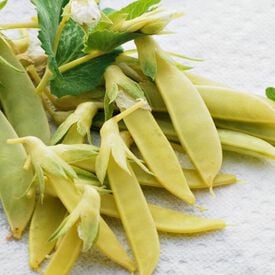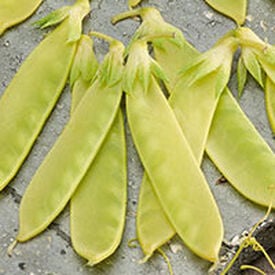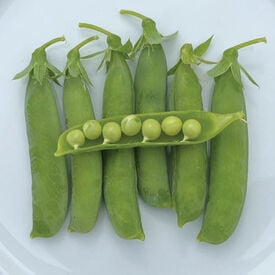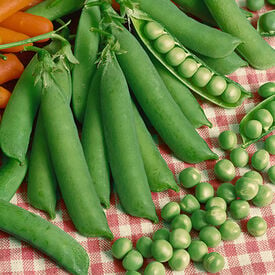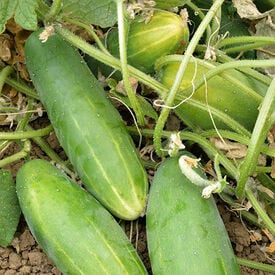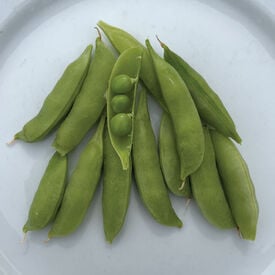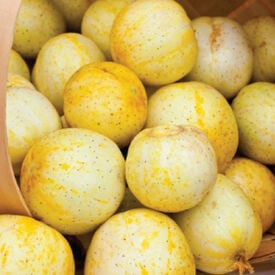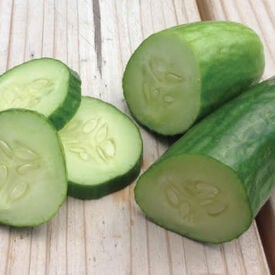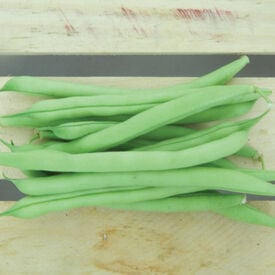Dwarf White Sugar peas are a compact, heirloom variety of edible-podded peas prized for their sweet, tender pods and early harvest. Growing to just about 2 to 3 feet tall, they require little to no support, making them ideal for small gardens and containers. These peas produce delicate white flowers followed by flat, crisp pods that can be eaten whole, either raw or cooked. Known for their mild, sugary flavor, Dwarf White Sugar peas are often harvested young for the best texture and taste. They thrive in cool weather and are typically among the first vegetables ready to harvest in the spring garden.
Ruby Moon Hyacinth Bean, also known as Lablab purpureus or simply Hyacinth Bean, is a unique and versatile legume known for its vibrant appearance and culinary potential. This heirloom variety is named for its striking ruby-red pods and dark green foliage, making it an attractive addition to both ornamental and edible gardens. Ruby Moon Hyacinth Beans are typically grown as annuals, but in tropical regions, they can be perennial. In terms of taste, the young pods and seeds of Ruby Moon Hyacinth Bean are edible and have a mild, nutty flavor similar to green beans. They can be consumed both raw and cooked. However, it's important to note that mature seeds contain toxic compounds and should not be eaten without proper processing. Ruby Moon Hyacinth Beans have a rich history, with their cultivation dating back centuries, primarily in Asia and Africa. They are valued not only for their culinary uses but also for their ability to fix nitrogen in the soil, enhancing soil fertility. This plant is categorized as a warm-season annual and typically matures in about 60-90 days, depending on growing conditions. The size of the Ruby Moon Hyacinth Bean plant can vary, but it generally reaches a height of 6-10 feet, making it suitable for trellises or fences. When it comes to yield, you can expect approximately 10-15 pounds of pods per plant or around 800-1,200 pounds per acre under ideal conditions. These beans thrive in full sun and well-drained soil, and they require a warm climate to grow successfully. Adequate moisture and support for climbing are essential for a bountiful harvest. With proper care, Ruby Moon Hyacinth Beans can be a delightful addition to your garden, offering both visual appeal and a tasty, nutritious addition to your plate.
Sugar Lace peas are a unique variety of edible-podded peas known for their attractive, semi-leafless vines with tendrils that help them cling and climb, reducing the need for support. These peas produce sweet, crisp pods that are stringless and ideal for fresh eating, stir-frying, or steaming. Unlike traditional shelling peas, Sugar Lace peas are enjoyed whole, pod and all, making them a convenient and nutritious garden snack. They are a late-season type with high yields and excellent disease resistance, thriving best in cool weather and well-drained soil. Their compact growth habit also makes them suitable for small gardens or container planting.
Opal Creek is a unique cross of a golden snow pea and a green snap pea. Produces a mild pea with flattened pods of a snow pea. Grows on 5-6 foot vines that produce an abundance of delicious yellow pods.
The Golden Sweet Pea is really the gold standard for yellow shelling peas! This yellow pod snow pea grows to be around 3 inches long. This pea has a wonderful sweet taste and can be eaten raw in salads or steamed as a side dish. The large 5-6 foot vines need to be trellised and will grow beautiful purple flowers. Certified Organic. Learn more about our organic seeds.
Thomas Laxton is an heirloom pea plant that is big and productive. At Urban Farmer we have trialed these a few times and they are always are favorite shelling pea. The peas are always sugary and delicious. This pea variety is named after the famous pea breeder, Thomas Laxton. This old heirloom pea is over a century old and has withstood the test of time. Each pod contains at least 8 peas and often up to 10! Make sure to support the Thomas Laxton's 3' vines with a trellis.
The Oregon Giant Pea plant has excellent yield potential. This variety is a home garden favorite that offers a great flavored pod if eaten while young and its peas have a great sugar flavor!
The Progress No. 9 Pea is a very prolific and early yielding shelling pea! This wrinkle-seeded pea is fast growing and produces plump dark green pods. Enjoy 7-9 delicious peas per pod that are perfect for soups or as a side dish. The Progress No. 9 holds well on the vine and is also disease resistant. Certified Organic. Learn more about our organic seeds.
The Juane Canary Melon is an old heirloom football shaped melon with a canary yellow rind and a creamy, white to green flesh. This 4-5 pound melon has a delicious sugar sweet taste that is perfect for summer picnics! This variety will keep well in full sun.
The Poinsett 76 Cucumber is a great slicing cucumber, as it is delicious cut up in salads or on sandwiches. This cucumber variety produces thick beautiful dark green fruits. The sun-loving Poinsett 76 will get to be 6-8 inches long when mature. This organic favorite is resistant to most cucumber diseases such as downy mildew, powdery mildew, angular leaf spot and anthracnose.
The Burpee Improved Bush Lime bean plants produce large pods, high yields, and perfectly shaped beans. Burpee Improved beans are both larger and thicker than normal lima beans. The growth is even more vigorous, with heavier foliage. The plants are uniformly upright.
Sugar Sprint Pea will sprint into the production of delicious peas! This fast maturing, heavy producing pea plant is one of the earliest maturing peas available. This pea variety produces 3" stringless snap peas over a long period. Sugar Sprint is heat tolerant and resistant to powdery mildew.
The Orient Wonder bean is a white seeded yard-long bean with tender pods. This type of pole bean is sometimes called asparagus or yard-long bean. Popular in warm and humid areas, where plants are vigorously vining. Extra-long, slender pods are slow to form seeds, resulting in more tender beans that can be harvested over an extended period. Orient Wonder is popular for specialty and ethnic markets and superior to standard strains due to its ability to set in cooler climates.
The Lemon cucumber is very tender, clean, crisp and sweet taste that is never bitter! This variety is a great cucumber for salads and pickling. Don't be fooled by this heirloom's unusual shape, these bright yellow balls are excellent for salads and pickling! This plant produces regular-sized vines that yield heavily and for a long time.
The Muncher cucumber is a favorite low acid slicer that is very prolific and tender. This cucumber plant variety produces a smooth nearly spineless, medium green cucumber that is crisp and delicious. Muncher can be pickled when young or eaten fresh when it reach 8-10" long and 2-3" wide. This cucumber's skin is thin and tasty, as it is easily eaten. The Muncher is non-bitter burpless cucumber that produces heavy yields and definitely a favorite!
The Sugar Magnolia Pea is a beautiful deep purple colored sugar snap pea that is the result of over 15 years of development! This spectacular beauty has a very sweet flavor and is best before the pods get too fat. Make sure that this climbing variety has a trellis, as its sturdy vines reach to be 6-7 feet tall. Add the Sugar Magnolia to fresh salads or as a steamed side dish for a pop of color!
Provider beans are a popular bush bean variety that has garnered attention for its reliable performance and ease of cultivation. Developed in the United States, Provider beans have a rich history dating back to the mid-20th century, when they were bred for both home gardens and commercial production. These beans are characterized by their compact growth habit, typically reaching about 18 to 24 inches in height, which makes them perfect for small spaces and easy to manage without staking. The pods are smooth and a vibrant green color, generally growing to about 5 to 6 inches long. Known for their excellent flavor and crisp texture, Provider beans are ideal for fresh eating, canning, or freezing. Harvesting is best done when the pods are young and firm, usually in mid to late summer, ensuring the best taste and quality. The plants are vigorous and produce high yields, demonstrating good resistance to common diseases. With their dependable growth, delightful flavor, and adaptability, Provider beans remain a favorite choice for both novice and experienced gardeners.
Mexican Sour Gherkin cucumber seeds produce small, grape-sized fruits that resemble miniature watermelons but have a refreshing cucumber-like taste with a tangy, citrusy twist. Also known as cucamelons or mouse melons, these vigorous, vining plants thrive in warm climates and are resistant to pests and diseases. They are easy to grow, requiring a trellis for support, and yield an abundant harvest throughout the season. Perfect for fresh snacking, pickling, or adding a unique touch to salads, Mexican Sour Gherkins are a delightful and eye-catching addition to any garden. These been around since pre-Columbian times, but were not brought into botanical classification until the mid-1800s. Despite being a member of the Cucurbitaceae family, they're only distantly related to the cucumber and will not cross with other cucumber varieties. This variety is also said to be the most cold-tolerant of all cucumbers, and will continue to fruit until the first frost.



